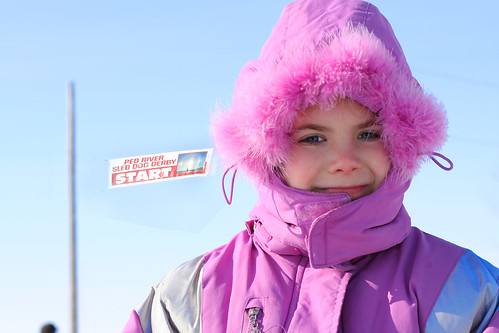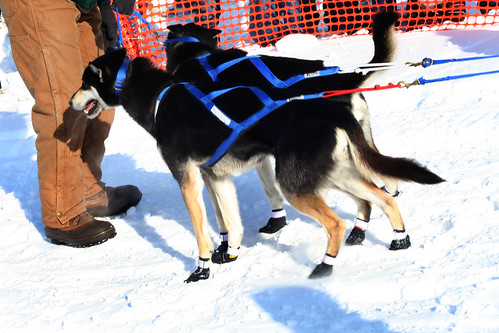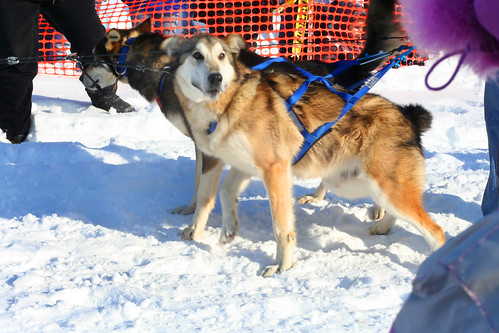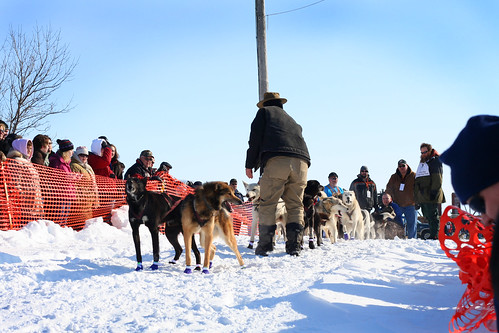Of course we’ll not make it to Alaska by Sunday to see the Iditarod mushers start, so I thought the next best thing would be to take the kids to see a local dog sled race. The Red River Sled Dog Derby start is about an hour and a half from us. I’ve resolved to try to get the kids out and do unique things that they might not otherwise be able to experience. I want to let them see or do things that encourage their interest in learning and having fun at the same time. AM really wants to be a dog sledder some day!
A Thousand Words Thursday is hosted by theMomJen at Cheaper Than Therapy!! Please stop by!!

PS: We’re rooting for DeeDee Jonrowe in the Iditarod – you can see her at www.deedeejonrowe.com





















5 comments:
such a cool thing to do with the kids!! LOVE that first pic!
WONDERFUL pics!!! What a nice camera you must have ....so crisp and prettyful!
I'd LOVE to see a sled race!
Wow, how cool! Looks like fun!
This is fabulous, Mel! What a wonderful goal/commitment you have made for your children!
Barbara
For the dogs, the Iditarod is a bottomless pit of suffering. Six dogs died in the 2009 Iditarod, including two dogs on Dr. Lou Packer's team who froze to death in the brutally cold winds. What happens to the dogs during the race includes death, paralysis, frostbite (where it hurts the most!), bleeding ulcers, bloody diarrhea, lung damage, pneumonia, ruptured discs, viral diseases, broken bones, torn muscles and tendons and sprains. At least 142 dogs have died in the race.
During training runs, Iditarod dogs have been killed by moose, snowmachines, and various motor vehicles, including a semi tractor and an ATV. They have died from drowning, heart attacks and being strangled in harnesses. Dogs have also been injured while training. They have been gashed, quilled by porcupines, bitten in dog fights, and had broken bones, and torn muscles and tendons. Most dog deaths and injuries during training aren't even reported.
On average, 52 percent of the dogs who start the race do not make it across the finish line. According to a report published in the American Journal of Respiratory and Critical Care Medicine, of those who do finish, 81 percent have lung damage. A report published in the Journal of Veterinary Internal Medicine said that 61 percent of the dogs who complete the Iditarod have ulcers versus zero percent pre-race.
Iditarod dog kennels are puppy mills. Mushers breed large numbers of dogs and routinely kill unwanted ones, including puppies. Many dogs who are permanently disabled in the Iditarod, or who are unwanted for any reason, including those who have outlived their usefulness, are killed with a shot to the head, dragged, drowned or clubbed to death. "Dogs are clubbed with baseball bats and if they don't pull are dragged to death in harnesses......" wrote former Iditarod dog handler Mike Cranford in an article for Alaska's Bush Blade Newspaper.
Dog beatings and whippings are common. During the 2007 Iditarod, eyewitnesses reported that musher Ramy Brooks kicked, punched and beat his dogs with a ski pole and a chain. Jim Welch says in his book Speed Mushing Manual, "Nagging a dog team is cruel and ineffective...A training device such as a whip is not cruel at all but is effective." "It is a common training device in use among dog mushers..."
Jon Saraceno wrote in his March 3, 2000 column in USA Today, "He [Colonel Tom Classen] confirmed dog beatings and far worse. Like starving dogs to maintain their most advantageous racing weight. Skinning them to make mittens.. Or dragging them to their death."
During the race, veterinarians do not give the dogs physical exams at every checkpoint. Mushers speed through many checkpoints, so the dogs get the briefest visual checks, if that. Instead of pulling sick dogs from the race, veterinarians frequently give them massive doses of antibiotics to keep them running. The Iditarod's chief veterinarian, Stu Nelson, is an employee of the Iditarod Trail Committee. They are the ones who sign his paycheck. So, do you expect that he's going to say anything negative about the Iditarod?
Most Iditarod dogs are forced to live at the end of a chain when they aren't hauling people around. It has been reported that dogs who don't make the main team are never taken off-chain. Chained dogs have been attacked by wolves, bears and other animals. Old and arthritic dogs suffer terrible pain in the blistering cold.
The Iditarod, with all the evils associated with it, has become a synonym for exploitation. The race imposes torture no dog should be forced to endure.
Margery Glickman
Director
Sled Dog Action Coalition, http://www.helpsleddogs.org
Post a Comment